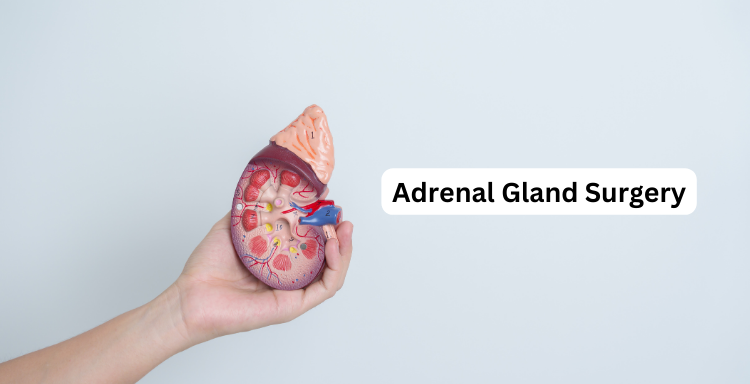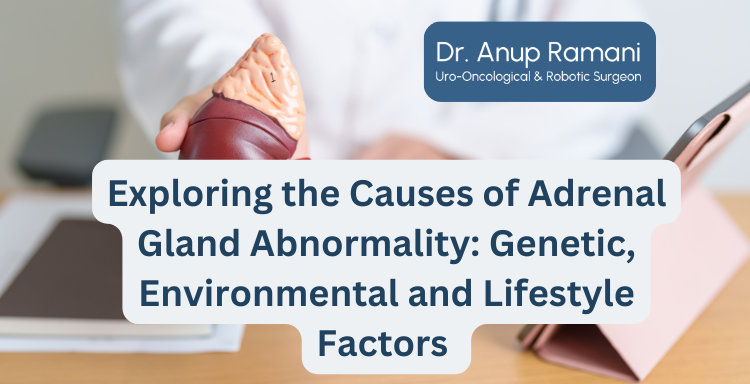Dr Anup Ramani @ Copyright 2024
By Dr. Anup Ramani
The adrenal glands are essential for regulating metabolism, blood pressure and immune function. Located above the kidneys, these small but powerful glands produce hormones such as cortisol, adrenaline and aldosterone, which play a crucial role in maintaining the body’s homeostasis. However, when these glands function abnormally, they can lead to serious health complications, affecting multiple bodily systems.
This article explores the causes of adrenal gland abnormalities, including genetic, environmental and lifestyle factors. Here, we will discuss how Adrenal Gland Abnormality caused by Genetic, Environmental and Lifestyle factors?

Causes of Adrenal Gland Abnormalities
Adrenal gland abnormalities occur when the glands produce too much or too little of certain hormones, leading to various disorders. Several factors contribute to these irregularities:
1. Genetic Factors
Genetic mutations can cause inherited adrenal disorders, increasing the risk of gland dysfunction. Some of the most common genetic causes include:
- Congenital Adrenal Hyperplasia – hereditary condition that affects cortisol and aldosterone production, leading to hormone imbalances from birth.
- Multiple Endocrine Neoplasia – A genetic disorder that causes tumors in the adrenal glands and other endocrine organs.
- Hereditary Pheochromocytoma and Paraganglioma – Tumors that arise due to inherited genetic mutations, leading to excessive adrenaline production.
- Familial Cushing’s Syndrome – A rare genetic condition where excessive cortisol is produced, resulting in metabolic disturbances.
These genetic disorders can lead to lifelong adrenal dysfunction, requiring medical intervention or surgery.
2. Environmental Factors
The adrenal glands are sensitive to external environmental triggers, which can contribute to their dysfunction.
- Chronic Stress – Long-term exposure to stress forces the adrenal glands to produce excessive cortisol, leading to adrenal fatigue over time.
- Exposure to Chemicals – Endocrine-disrupting chemicals found in plastics, pesticides and industrial waste can interfere with hormone production.
- Radiation and Heavy Metals – Prolonged exposure to radiation therapy, lead and mercury can damage adrenal gland cells.
- Autoimmune Disorders – Conditions like autoimmune adrenalitis cause the immune system to mistakenly attack the adrenal glands, leading to Addison’s disease.
3. Lifestyle Factors
Certain lifestyle choices increase the risk of adrenal gland abnormalities:
- Poor Diet – A high intake of processed foods and refined sugars disrupts adrenal hormone balance, leading to metabolic disorders.
- Sleep Deprivation – Inadequate sleep affects cortisol regulation, leading to adrenal exhaustion.
- Excessive Alcohol and Caffeine Consumption – These substances stimulate adrenal hormone release, causing long-term gland fatigue.
- Physical Inactivity – A sedentary lifestyle contributes to obesity, high blood pressure and insulin resistance, which put stress on the adrenal glands.
Making healthier lifestyle choices can help prevent or manage adrenal dysfunction effectively.
Impact of Adrenal Gland Dysfunction on Health
When adrenal glands function improperly, it leads to serious metabolic, cardiovascular and immune complications.
1. Metabolic Disruptions
The adrenal glands regulate metabolism by controlling glucose, fat and protein balance. Hormonal imbalances can cause:
- Weight Gain – Excess cortisol production leads to fat accumulation, particularly in the abdomen.
- Unexplained Weight Loss – Addison’s disease causes muscle wasting and a significant loss of appetite.
- Blood Sugar Fluctuations – High cortisol levels contribute to insulin resistance, increasing the risk of diabetes.
2. Blood Pressure Irregularities
Adrenal hormones regulate blood pressure by controlling sodium and water retention. Dysfunction can lead to:
- High Blood Pressure – Caused by excessive aldosterone or adrenaline production, commonly seen in pheochromocytoma and Cushing’s Syndrome.
- Low Blood Pressure – Addison’s disease can result in chronic low blood pressure, leading to dizziness and fainting.
3. Immune System
- Weakened Immunity – High cortisol levels suppress immune responses, making individuals vulnerable to infections.
- Chronic Inflammation – Low cortisol production, as seen in Addison’s disease, results in excessive inflammation and immune system overactivity.
Proper adrenal function is essential for maintaining overall health and resilience against infections and diseases.
Treatment Options for Adrenal Gland Abnormalities
Adrenal gland disorders require medical treatment, which may include medications, hormone replacement therapy or surgery.
1. Medications and Hormone Therapy
- Corticosteroid Replacement Therapy – Used for Addison’s disease to supplement deficient cortisol levels.
- Aldosterone Antagonists – Helps manage conditions like hyperaldosteronism to control blood pressure.
- Beta-Blockers – Used in cases of pheochromocytoma to regulate excessive adrenaline production.
2. Robotic Adrenalectomy: A Modern Approach to Surgery
In cases where adrenal tumors or severe hormone imbalances are present, surgical removal of the adrenal gland is the most effective solution. Robotic adrenalectomy has emerged as the preferred surgical approach due to its minimal invasive nature and faster recovery time.
How Robotic Adrenalectomy Works?
- Small Incisions – Three tiny incisions are made in the abdomen.
- Robotic Precision – The Da Vinci robotic system provides unparalleled accuracy, minimizing damage to surrounding tissues.
- Minimal Blood Loss – The procedure is virtually bloodless, reducing the risk of complications.
- Quick Recovery – Patients typically return to daily activities within two weeks.
Advantages of Robotic Adrenalectomy
- Less Pain and Scarring – Smaller incisions result in less postoperative pain and minimal scarring.
- Shorter Hospital Stay – Most patients are discharged within 4 days after surgery.
- Faster Recovery – Patients resume normal activities much quicker compared to traditional open surgery.
- Lower Risk of Complications – The precision of robotic surgery reduces the likelihood of infections and damage to nearby organs.
Robotic adrenalectomy is now widely available in Mumbai and other major cities in India, performed by expert adrenal gland surgeons specializing in minimal invasive techniques.
Adrenal Gland Surgery in India: A Global Medical Hub
India is emerging as a leading destination for adrenal gland treatment, offering advanced robotic surgeries at affordable costs.
- Major medical centers in Mumbai, Delhi and Chennai specialize in robotic adrenalectomy.
- Experienced adrenal gland surgeons in India ensure high success rates for robotic procedures.
- Cost-effective treatment options make India a preferred choice for international patients.
Conclusion
Adrenal gland abnormalities can arise due to genetic mutations, environmental toxins and poor lifestyle choices, leading to serious metabolic, cardiovascular and immune complications. Early diagnosis and timely treatment are essential to prevent long-term health consequences.
For severe cases, robotic adrenalectomy offers a minimal invasive, highly effective solution that enables faster recovery with fewer complications. With India becoming a global hub for robotic adrenal gland surgery, patients now have access to world-class treatment at competitive costs.
Read More Articles on Adrenal Gland Treatment
About Author

Uro-Oncological & Robotic Surgeon
Dr. Anup Ramani is a robotic uro-oncological surgeon and an internationally recognized expert in robotic surgery for prostate, kidney and urinary bladder cancers. With more than two decades of robotic experience and 2,000+ robotic procedures, he brings unmatched precision and outcomes to complex uro-oncology cases. He is widely published in his field and is known for a personal, transparent approach-often spending over an hour in initial consultations to educate patients on its disease, surgery and recovery. His expertise spans prostate cancer treatment, kidney and bladder cancer surgery, adrenal gland surgery, kidney stone treatment, penile cancer surgery and enlarged prostate management. Dr. Ramani advocates the advantages of robotic surgery-magnified 3D vision, tremor-filtered precision, minimal scarring, lower blood loss and faster recovery-helping patients return to life sooner.
Table of Contents
Recent Blogs
Best Uro-Oncological surgeon
Specialist in India for Robotic Surgery
MCh, DNB, MS, DNB
Dr. Anup Ramani
CONTACT
Uro-Oncologist in India,
Best Robotic Surgeon for Uro Oncology Surgery
1407, One Lodha Place Next to World Towers Senapati Bapat Marg, Worli, Mumbai. 400013.
Dr Anup Ramani @ Copyright 2024 – Website Maintenance, SEO & GEO by Opal Infotech
- Partial penectomy is done in cases where glans and distal penis is involved with carcinoma.
- Partial penectomy is a type of organ-preserving surgery. Preservation of sexual and micturational function depends on the surgical dissection and reconstruction of residual urethra.
- Patients who develop stones in the kidney or ureter, often experience severe pain.
- This condition usually needs a procedure to remove the kidney stones.
- This procedure is called ureteroscopy and is performed very commonly.
- It does not require any cuts and hence it is painless.
- The procedure is performed with an endoscope inserted through the penis under spinal anesthesia.
- The scope is inserted through the penis into the kidney and stones are dissolved with a laser.
- The procedure takes about 40-50 minutes.
- A catheter (urine pipe) is kept after the procedure to drain the bladder. A stent is kept in the kidney at the same time.
- Patient is mobile and walking in the room the same evening.
- Hospital stay is one night and patient is discharged the next day after removal of the catheter.
- Patient has to come back after six weeks to remove the stent in the kidney.
- Patients can resume office a week after surgery and heavy activities like running, weight lifting, a month after the procedure.
- We offer fixed packages for this procedure which can be obtained by calling our helpline +91 9967666060.
- Men with an enlarged prostate, which is a normal ageing changes, often experiencing difficulty passing urine. This condition usually needs a procedure to trim the prostate and relieve the blockage.
- This procedure is called TURP and is performed very commonly.
- It does not require any cuts and hence it is painless.
- The procedure is performed with an endoscope inserted through the penis under spinal anaesthesia.
- The overgrown prostate is dissolved with a laser bloodlessly.
- The procedure takes about 40 minutes.
- A catheter (urine pipe) is kept after the procedure to drain the bladder.
- Patient is mobile and walking in the room the same evening.
- Hospital stay is two nights and patient is discharged with the catheter, which is removed after 4 days.
- Patients can resume office a week after surgery and heavy activities like running, weight lifting, a month after the procedure.
- We offer fixed packages for this procedure which can be obtained by calling our helpline +91 9967666060.
-
Robotic adrenalectomy is a sophisticated, complex surgery and it is very important that an experienced surgeon performs this surgery to avoid major complications.
-
Once the anesthesia is done, and patient positioned, three micro cuts (3mm each) are made in the patient’s abdomen.
-
The arms of the Da Vinci robot are connected to the cuts via ports (tubes).
-
Dr. Ramani then sits in the controlling console to perform the surgery.
-
On an average, a robotic adrenalectomy takes one hour.
-
The surgery is almost completely bloodless and there has never been any need to transfuse blood after surgery.
-
A urine catheter and bag to drain the bladder is inserted during surgery.
-
A tiny drain pipe may be inserted in the surgical side of the abdomen, connected to a bag.
-
Patient is kept nil-by-mouth the day of the surgery, with IV fluids. Sips of water are started the next day and solid food by day three.
-
The drain pipe, if kept, is removed in the room on day 2 after surgery.
-
The catheter is removed on day two after surgery.
-
Total hospital stay for robotic adrenalectomy is 4 nights (including night before surgery).
-
Post discharge, a doctor from the surgical team visits the patient at home/ hotel room once every day.
On the day of discharge, patient is totally self-sufficient. They are able to walk freely without any pain, dress themselves, shower, toilet and they do not need to hire any nurse or help at home. Almost all patients are back to work within 2 weeks of surgery.
Heavy activities like running, weight lifting can be resumed after a month
Follow up after an adrenalectomy is in the form of CT scans, once a year for 5 years.
Local patients usually meet Dr. Ramani after two weeks to discuss report.Outstation patients are counselled on a phone consultation.
- Dr. Ramani is one of the very few surgeons in India who has the expertise to perform a robotic surgery for bladder cancer, which includes removing the urinary bladder and reconstructing a new bladder robotically.
- Robotic radical cystectomy is an extremely sophisticated, complex surgery and it is very important that an experienced surgeon performs this surgery to avoid major complications.
- Once the anaesthesia is done, and patient positioned, six micro cuts (3mm each) are made in the patient’s abdomen.
- The arms of the Da Vinci robot are connected to the cuts via ports (tubes).
- Dr. Ramani then sits in the controlling console to perform the surgery.
- On an average, a robotic radical cystectomy with an ileal conduit takes 3-4 hours.
- The surgery is almost completely bloodless and there has never been any need to transfuse blood after surgery.
- A urine catheter and bag to drain the new bladder is inserted during surgery.
- Two tiny drain pipe in inserted in the surgical side of the abdomen, connected to a bag.
- Patient is kept nil-by-mouth for 4 days after surgery with IV supplementation of patient’s daily requirements of calories, fats, carbohydrates, proteins and electrolytes.
- The drain pipes are removed in the room on day 3-5 after surgery.
- Total hospital stay for radical cystectomy is 8 nights (including night before surgery).
- Post discharge, a doctor from the surgical team visits the patient at home/ hotel room once every day.
- On the day of discharge, patient is totally self-sufficient. They are able to walk freely without any pain, dress themselves, shower, toilet and they do not need to hire any nurse or help at home.
- Almost all patients are back to work within 6 weeks of surgery. Heavy activities like running, weight lifting can be resumed after two months.
Follow up after a radical a cystectomy is in the form of CT scans, once a year for 5 years.
Histopathology report: Local patients usually meet Dr. Ramani after two weeks to discuss report.
Outstation patients are counselled on a phone consult. Depending on the report, patient may or may not need chemotherapy after surgery.
If chemo is needed, patients may choose to get it done with a medical oncologist of their choice or avail the services of one of the four medical oncologists on our team.
- Robotic partial nephrectomy is a sophisticated, complex surgery and it is very important that an experienced surgeon performs this surgery to avoid major complications. Robotic radical (total) nephrectomy is
- relatively easier but still requires significant experience to consistently deliver results.
- Once the anaesthesia is done, and patient positioned, five micro cuts (3mm each) are made in the patient’s abdomen.
- The arms of the Da Vinci robot are connected to the cuts via ports (tubes).
- Dr. Ramani then sits in the controlling console to perform the surgery.
- On an average, a robotic radical nephrectomy takes one hour and a robotic partial nephrectomy takes about an hour and half.
- The surgery is almost completely bloodless and there has never been any need to transfuse blood after surgery.
- A urine catheter and bag to drain the bladder is inserted during surgery.
- A tiny drain pipe in inserted in the surgical side of the abdomen, connected to a bag.
- Patient is kept nil-by-mouth the day of the surgery, with IV fluids. Sips of water are started the next day and solid food by day three.
- The drain pipe is removed in the room on day 3 after surgery. The catheter is removed on day two after surgery.
- Total hospital stay for radical/partial nephrectomy is 4 nights (including night before surgery).
- Post discharge, a doctor from the surgical team visits the patient at home/ hotel room once every day.
- On the day of discharge, patient is totally self- sufficient.
- They are able to walk freely without any pain, dress themselves, shower, toilet and they do not need to hire any nurse or help at home.
- Almost all patients are back to work within 2-3 weeks of surgery.
- Heavy activities like running, weight lifting can be resumed after a month.
- Follow up after a radical/partial Nephrectomy is in the form of CT scans, once a year for 5 years.
- Local patients usually meet Dr. Ramani after two weeks to discuss report.
- Outstation patients are counselled on a phone consultation.







